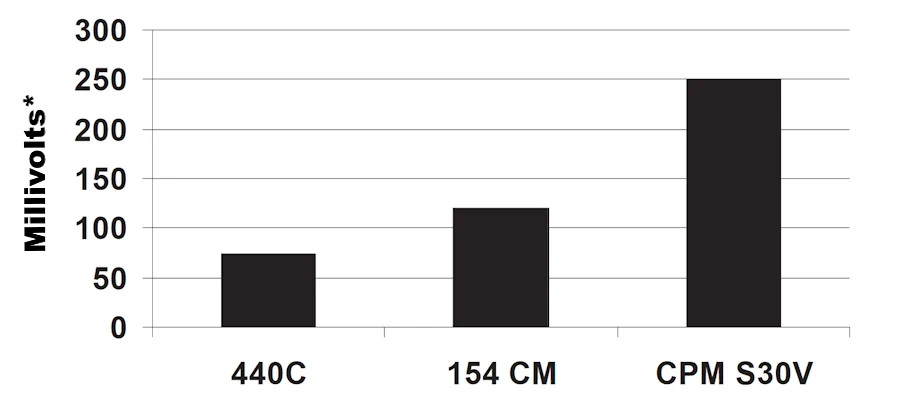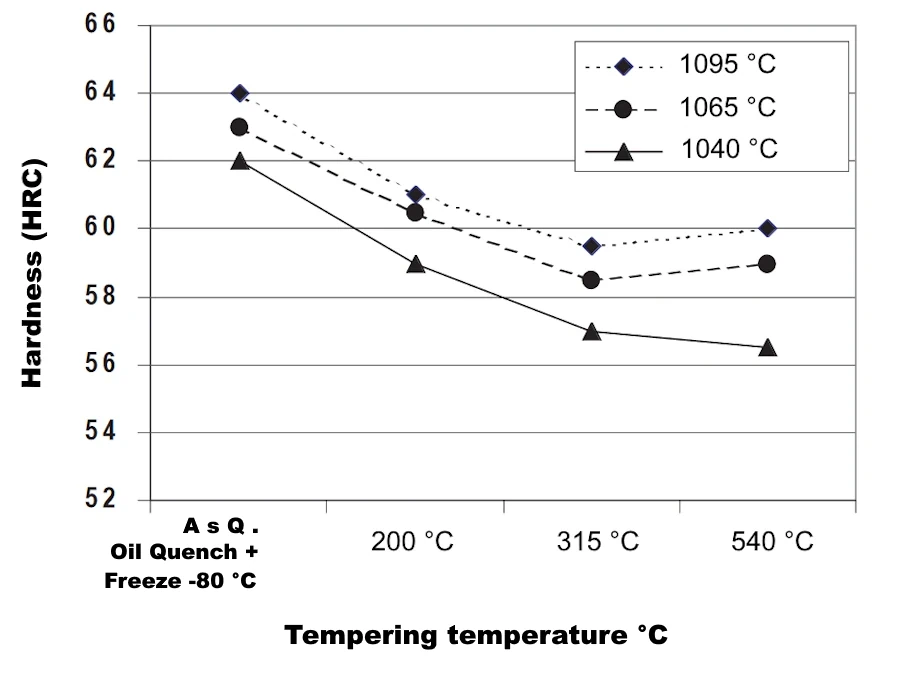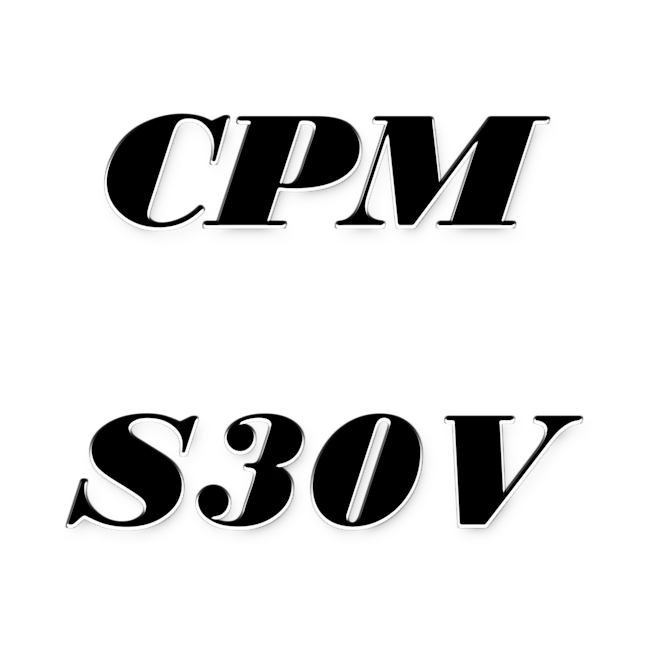CPM S30V is a martensitic stainless steel designed to provide the best combination of strength, wear resistance and corrosion resistance. Its chemical composition has been specially balanced to promote the formation of vanadium carbides, which are harder and more effective than chromium carbides in providing wear resistance. CPM S30V provides significant improvement in strength over other high-hardness steels such as 440C and D2, and its corrosion resistance is equal to or greater than 440C in a variety of environments.
The CPM process produces a highly homogeneous, high quality steel characterized by excellent dimensional stability, grindability and strength compared to steels produced by conventional methods.
S30V steel is the gold standard of the stainless steel powder industry. S30V is produced using amorphous metal alloy technology, better known to knife enthusiasts under the abbreviation CPM (Crucible Particle Metallurgy process). Other popular steel grades, CPM440V (S60V), CTS-BD30P, CPM420V (S90V), and CPM3V, are also produced using this technology. It is recommended to temper S30V to 58-61 units on the Rockwell scale. Despite its considerable hardness, an S30V blade is easy to sharpen.
CPM S30V is a powdered stainless steel that was developed in collaboration with knifemaker Chris Reeve. It is one of the strongest and most durable steels available on the market and is a popular choice for high-quality knives and other cutting tools. Made in the USA, it was developed in 2001 by Crucible Industries to provide the best combination of strength, wear and corrosion resistance.
It is also interesting that famous knife makers took part in the development, in particular Phil Wilson, Sel Glesser, Ernest Emerson, Tony Marfione, William Harsey Jr., Tom Mayo, Jerry Hossom and Paul Boss, Chris Reeve. As a result, we got a very good knife steel with an optimal hardness of 58-61 HRC and a well-balanced chemical composition.
Chemical composition
Chemical composition of steel grade CPM S30V | ||||||||||
| C | Cr | Mo | V | Mn | Si | W | P | Co | N | Fe |
| 1,45 | 14,0 | 2,0 | 4,0 | 0,5 | 0,5 | 0,4 | 0,03 | 1,0 | 0,5 | Other |
During the production of this steel, vanadium carbides are formed, the properties of which give the steel greater strength than the use of chromium carbides. In addition, vanadium carbides allow for a more perfect grain of steel. The steel is chemically balanced to ensure optimal precipitation and crystallization of carbides, which subsequently give the steel increased wear resistance without serious degradation of strength and impact toughness.
Application of CPM S30V Stainless Steel
- Special wear-resistant cutlery;
- Plastic injection and extrusion feed screws and dies;
- Check valve components;
- Pelletizing equipment;
- Wear-resistant components for food and chemical processing.
Note: these are some typical applications. Your specific program should not be accepted without independent research and assessment of suitability.
Physical properties
- Elastic modulus: 221 hPa;
- Density: 7.47 g/cm3;
- Thermal conductivity at 93 °C: 17.31 W/m-°K;
- Coefficient of thermal expansion:
20 - 200 °C: 11.0X10-6 mm/mm/°C;
20 - 315 °C: 11.5X10-6 mm/mm/°C;
Mechanical properties
Longitudinal strength is about 25-28 ft-lbs, transverse strength of CPM S30V is four times that of 440C or 154CM. These higher transverse strength results indicate that CPM S30V is much more resistant to chipping and breaking in applications that may encounter lateral loading. In knife making, its higher transverse strength makes CPM S30V particularly suitable for large blades.
Edge retention
| Steel grade | % |
| CPM S30V | 145 |
| 154CM | 120 |
| 440C | 100 |
The CATRA (Cutlery & Allied Trades Research Association) testing machine performs a standard cutting operation and measures the number of silicon-impregnated cut cards (TCC = total cut card count). This is considered a measure of relative wear resistance.
Corrosion resistance
Measurement of average pitting corrosion potential from polarization curves obtained in 5% NaCl (sodium chloride) solution at room temperature: (high pitting corrosion potential voltage indicates better corrosion resistance.)

*vs. Hg/HgO reference electrode
Thermal treatments
- Forging: 1150 °C. Do not forge below 950 °C.
- Annealing: heat to 900 °C, hold for 2 hours, cool slowly at a rate of no more than 15 °C per hour to 595 °C, then cool in a furnace or in air to room temperature.
Annealed Hardness: about BHN 255
Stress relieving
- Annealed parts: heat to 595 - 705 °C, hold for 2 hours, cool in a furnace or in air.
- Hardened parts: heat to 15 - 30 °C below the original tempering temperature, hold for 2 hours, then cool in a furnace or in air.
- Straightening: best done at 200 - 430 °C.
Hardening
- Preheating: heating to 845 - 870 °C. Leveling.
- Austenitization: 1035 - 1095 °C, holding time at temperature 15 - 30 minutes.
- Quenching: air or quenching under positive pressure (at least 2 bar) to a temperature below 50 °C, or quenching in a salt or intermittent oil medium to a temperature of about 540 °C, then air cooling to a temperature below 50 °C.
- Temper: double tempering at 200 - 400 °C. Keep for at least 2 hours each time. Freezing can be used between the first and second tempering. Freezing helps to achieve maximum hardening and should always be followed by at least one tempering.
NOTE: for optimum stress relief, CPM S30V can be tempered at 540 - 550°C. Tempering in this range may result in reduced corrosion resistance. - Size change: +0.05 to +0.10% in martensitic condition. Presence of retained austenite may reduce net growth. When tempering at 200 - 400 °C, freezing may be required to minimize retained austenite.
Recommended heat treatment:
Austenitization at 1065 °C. Quenching to below 50 °C. Double temper at 315 °C for at least 2 hours each. Cool to warm between temperings. Sub-zero temperature treatment may be added between temperings.
Aim hardness: 58-61 HRC.
Note: the properties shown on this page are typical values. Normal variations in chemistry, dimensions and heat treatment conditions may cause deviations from these values.
Reaction to heat treatment - hardness (HRC) CPM S30V | ||||||
| Austenitization temperature | ||||||
| 1040 °C | 1065 °C | 1095 °C | ||||
| Oil | Oil + Freezing | Oil | Oil + Freezing | Oil | Oil + Freezing | |
| Tempering temperature | -80 °C | -80 °C | -80 °C | |||
| As Quenched | 60,5 | 62 | 62 | 63 | 63,5 | 64 |
| 200 °C | 57,5 | 59 | 57,5 | 60,5 | 59,5 | 61 |
| 315 °C | 57,5 | 57 | 59 | 58,5 | 59 | 59,5 |
| 540 °C | 57 | 56,5 | 59,5 | 59 | 58,5 | 60 |
| Results may vary with hardening method and section size. Salt or oil quenching will give maximum response. Vacuum or atmosphere cooling may result in up to 1-2 HRC points lower. | ||||||
| Minimum Time at Aust. Temp. | 30 min. | 30 min. | 15 min. | |||
| Minimum Number of Tempers | 2 | 2 | 2 | |||

Machinability and Grindability
In the annealed condition, CPM S30V is much easier to machine than CPM S90V and is comparable to that of D2. Similar grinding equipment and practices used for high speed steels are recommended. “SG” type alumina wheels or CBN wheels have generally given the best performance with CPM steels.
S30V steel is designed specifically to meet the knife industry's needs for quality steel. It is an excellent material for any knives. This steel quickly gained popularity and is now widely used in the manufacture of knives by many companies. This steel has been subjected to numerous tests by knife manufacturers, and their opinions agree: blades made from this steel hold an edge perfectly, and their anti-corrosion properties are also excellent.
